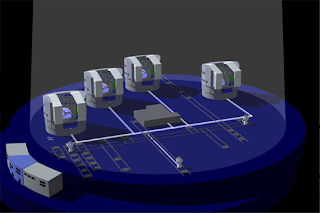Long ago, when we visited with a group of astronomy students at the IAR (Argentine Institute for Radio Astronomy), many were surprised that the main telescope 30 meters in diameter rarely came to be defined (in resolve astronomical language) the apparent diameter of the Moon.
 |
| One of the IAR twin antennas 30 meters in diameter. |
As can be such a monstrous antenna can only see that?
The point is that there is one detail: it also depends on the "color" (wavelength or lambda, λ-) that are observing.
Normally when solving questions that have a telescope, is in the eye, so use a simplified formula
seconds Resolution arc (") = 11.4 / diameter (cm),
But the real formula is:
Resolution = 206,205 * λ / diameter of the telescope.
Of course, in the same units. This value is also known as the Dawes limit .
see, if we replace by values \u200b\u200bof the telescope (that is sensitive to λ = 21 cm.)
Resolution = 206 265 * 0.21 m. / 30 m. = 1443 = 24 minutes of arc.
Since the Moon has an apparent diameter of 30 arc minutes ....
 |
| On the left, looks like the moon with a telescope of 10 cm in diameter. On the left, simulation on how the "see" the 30-meter radio telescope. |
A mirror or antenna must have a minimum quality to the telescope reaches its maximum capacity to resolve detail.
This happens when the maximum irregularity with reference to the perfect curve is less than
λ / 8
In an optical telescope, which sees on average in yellow (λ = 0.56 thousandths of a millimeter) maximum resolution is reached when irregularities of the mirror is less than 0.56
microns / 8 = 0.07 microns.
The telescope you use must have unfailingly superior quality to 7 hundred thousandths of a millimeter to look good !!!!.
To have a better idea of \u200b\u200bhow little the value, if a mirror of 10 cm. enlarges to 10 kilometers in diameter, the irregularities to the widening to 7 mm .....
 |
| An astronomical mirror side. The top is a parable that reflects light. Larger surface irregularities. If these are smaller than 0.07 microns, the mirror is considered perfect. |
The radio telescope that detected λ = 21 cm, the parable must be better than about 3 cm. For this reason these devices can sometimes use a metallic fabric, that radio waves are like a perfect mirror.
 |
| The central part of the antenna is solid, in contrast to the edges is of metal. For radio waves of 21 cm. is as solid as the center. |
As images are taken with telescopes so good then?
radioastronomers Poque use a "trap" called interferometer.
placing two antennas facing the same object at the same time, you can analyze the signal and reconstruct the image with the definition of the separation of the antennas. There
the Very Large Interferometer (VLI) and the VLA in New Mexico. Are 27 antennas that extend for 30 km.
 |
| VLA. |
Look at what can be done with interferometers ....
 |
| The galaxy M51, where you see the spiral structure and the resolution of a few arc seconds .... |
If in fact being used. The main telescope in the world in Chile, Cerro Paranal, four telescopes that can operate separately or together as an interferometer.
 |
| The four telescopes at Paranal are connected underground, which combines the light beams of the four, reaching the maximum resolution. |
0 comments:
Post a Comment